
|

|

|
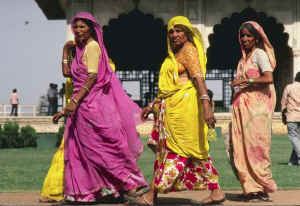
|

|
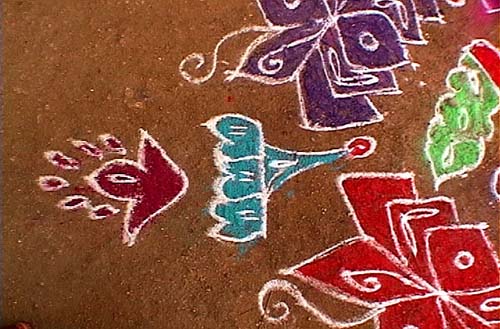
|
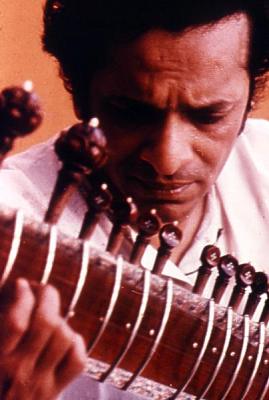
|

|
Dance in India
Classical dance in India is thousands of years old. There are many kinds of dance, each with some form of religious background. Though different, they all convey meaning using every part of the body. Eyes, hands, legs, feet, and face come together in the dance and music to set a mood and tell a story.
| Bharata Natyam | Kathakali |
| Odissi | Kathak |

Bharata Natyam:

| Bharata Natyam may be the oldest form of classical Indian dance.
It is thought to have originated in the temples of Tamil Nadu in south India, where is was intended to honor and worship
God. Even today, there is a great deal of the original religious influence, as every preformance begins with
a danced prayer to God and an "alarippu", in which the dancer presents and dedicates the body to God. The name
comes from "bha", meaning emotion, "ra", meaning melody, and "ta" meaning tal, or rhythm.
A Bharata Natyam dance is a solo preformance, but the dancer is accompanied by light instrumentation and a vocalist who sings both words and the beats of the drums. It is a mixture of pure dance and dance to tell a story. During the dance, the preformer keeps the upper body upright while the legs are held in a bent-knee, turned out position. In general, the body is thought of as a series of three triangles. A Bharata Natyam recital has a definate order of pieces, each with a purpose and time signature. |

Kathakali
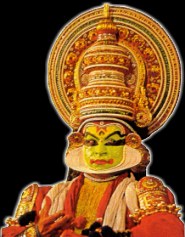
|
|
Kathakali costume from www.rbcradio.com |
| Kathakali is a type of dance-drama that comes from Kerela,
located in South India. It is thought to have originated in the 17th century and has its roots in Indian
mythology. It is called a "dance-drama" because the dance is not always the main focus. Instead, the
preformer tells a well known story from Hindu epics or scriptures using facial expression and specific hand gestures.
The costumes for Kathakali
are quite elaborate: for instance, dancers wear huge, rounded skirts. Their headgear may be made out of carved wood and
the heavy makeup often takes hours to apply.
Much of the story that accompanies the dance is told by singers accompanied by precussion instruments. |

Odissi

| Like many other Indian dances, Odissi originated in temples, as a way to
honor God. It may have originated in the 2nd century BCE in Orissa. Odissi dancing maintains a tie between the dance and
the sculptures on the ancient temples and caves of India. Defined poses are often held before a smooth and flowing transition to the next
section of the dance. Many dances and dance music follow the popular story of Radha and Krishna or other ancient stories of love.
Distinguishing positions of Odissi dance include the balenced standing position; the "tribhanga", in which the head and hip are thrust to one side while the upper body angles in the other direction; and the "chauka", where the toes and legs are pointed to the sides and the feet are slightly apart with knees bent. The dancer wears silver jewelry and a sari that has been stitched to hold in position. |

Kathak:
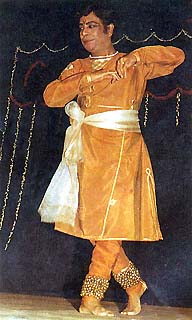
|
|
Kathak dancer Birju Maharaj from www.upindia.org |
| Kathak dancing comes from northern India. It is thought to have originated
with traveling storytellers called Kathaks. They told mythological stories using hand gestures, instruments, and vocal music.
Kathak dancing today is accompanied by percussion instruments that set complex rhythms that the dancer must match. Both men and
women perform Kathak.
Kathak is known for its fast footwork, complex rhythms, and the many spins executed by the dancer. The turns often end in defined poses. The dancer wears strings of bells on the feet, like Bharata Natyam, and must use different parts of the foot to create different sounds. This means that any single step taken by a Kathak dancer is really a set combination of up to 12 steps that must follow strict rhythm. The choice of step to create sound is coordinated with the instrumentalist. Unlike other forms of Indian dance, the emphasis in Kathak is clearly on footwork. |


To top of page
The creator of this site would like to thank:"Nadanam" (at http://www.nadanam.com) for detailed information on Bharata Natyam and Odissi dance.
The magazine "Bansuri" for help with the history of Kathak and its performance today (Bansuri, vol 13, 1996 Raga-Mala Performing Arts of Canada.)